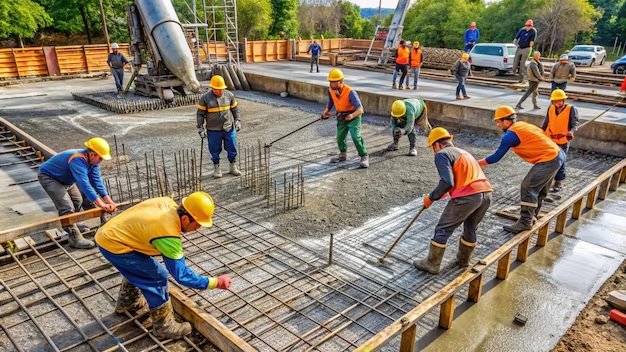
In the dynamic world of construction, efficiency and productivity are paramount. Whether you’re building a skyscraper or renovating a home, one thing is certain—having the right mobility tools and vehicles can make all the difference. On-site mobility not only enhances productivity but also ensures safety and cost-effectiveness. Let’s explore the essential tools and vehicles that every construction site should consider to keep things moving smoothly.
The Role of Mobility in Construction
In construction, time is money. Delays can lead to increased costs and frustrated clients. Mobility solutions ensure that workers and materials can be transported swiftly from one part of the site to another. Vehicles like forklifts and skid steers are vital for lifting heavy loads, while tools like dollies and carts make moving smaller items a breeze. Keeping a construction site mobile can significantly reduce downtime, leading to more efficient project completion.
Traditionally, mobility in construction was limited to manual labor and basic vehicles. However, with technological advancements, the industry has seen a boom in innovative mobility solutions. These modern tools not only speed up processes but also reduce the physical strain on workers, leading to fewer injuries and better job satisfaction. The evolution of mobility tools in construction has also opened doors for more complex and large-scale projects to be tackled with ease.
On large construction sites, the variety of mobility tools available can sometimes be overwhelming. It’s crucial to understand the specific needs of your project before investing in these tools. By doing so, you ensure that you’re not only optimizing for efficiency but also for safety and cost. With the right mix of traditional and modern mobility solutions, construction sites can achieve optimal performance levels.
Power of Specialized Construction Vehicles
Specialized vehicles play a pivotal role in modern construction. They are designed to handle specific tasks effectively, reducing the time and effort required. Bulldozers, for instance, are essential for clearing land and preparing the foundation. Cranes, on the other hand, make it possible to lift heavy materials to great heights, making them indispensable for high-rise projects.
Backhoes are another versatile vehicle commonly found on construction sites. Their unique design allows them to dig trenches and move materials effortlessly. For smaller projects or areas with limited space, mini excavators offer the same functionality as traditional excavators but in a compact form. This adaptability makes them highly valuable on diverse job sites.
The introduction of electric and hybrid vehicles in construction is changing the game. These eco-friendly alternatives not only reduce emissions but also offer quieter operations, making them ideal for urban projects. The reduced noise levels ensure minimal disruption to surrounding areas, allowing construction work to proceed smoothly even in noise-sensitive zones.
Portable Power Solutions
In the heart of a construction site, power is everything. Portable generators have become an indispensable tool for providing electricity to remote areas of a site. These generators ensure that tools and equipment remain operational, even when access to the main power grid is limited or unavailable.
Battery-operated tools are also gaining popularity. These tools offer the flexibility to work in areas where traditional power sources might be challenging to access. With advancements in battery technology, these tools now offer longer run times and greater power, making them a reliable choice for many construction tasks.
Solar-powered devices are also making their mark in the construction industry. These eco-friendly solutions harness the sun’s energy to provide power to various tools and equipment. By reducing the reliance on traditional fuels, solar-powered tools contribute to both cost savings and environmental conservation.
Adapting to Diverse Terrains
Construction sites are rarely flat and easy to navigate. Adapting to challenging terrains is crucial for maintaining efficiency. All-terrain vehicles (ATVs) are invaluable in such scenarios. They can traverse rough landscapes with ease, transporting workers and materials across the site swiftly.
Tracked vehicles, unlike their wheeled counterparts, distribute weight more evenly, making them ideal for soft or muddy terrains. These vehicles ensure that work continues even under challenging ground conditions, preventing delays and potential damage to the site.
For particularly challenging terrains, toy haulers campers can be an excellent solution. These vehicles are designed to transport heavy machinery and tools across vast distances, ensuring that everything arrives safely and on time. Their durability and robustness make them a favorite among construction teams dealing with diverse landscapes.
The Future of Mobility in Construction
The future of on-site mobility in construction looks promising. With the increasing integration of technology, autonomous vehicles and drones are set to revolutionize the way construction sites operate. These innovations promise to reduce human error, enhance safety, and further increase efficiency.
Virtual and augmented reality tools are also on the horizon, offering new ways to visualize and plan mobility logistics on a construction site. By simulating different scenarios, construction teams can better prepare and optimize their strategies for enhanced productivity.
The integration of AI and machine learning in construction vehicles is another exciting development. These technologies can predict maintenance needs, optimize fuel usage, and even plan efficient routes across a site. By harnessing the power of data, construction teams can make informed decisions that benefit the entire project.
Conclusion
In conclusion, the importance of on-site mobility in construction cannot be overstated. From specialized vehicles to portable power solutions, the right tools can significantly enhance efficiency and safety. By staying updated with the latest advancements in mobility solutions, construction teams can ensure they remain competitive and deliver projects on time. Whether you’re a seasoned professional or new to the industry, investing in advanced mobility solutions is a step towards a successful construction endeavor.








